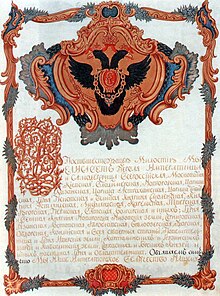Balthasar Freiherr von Campenhausen

Johan Balthasar Freiherr von Campenhausen ( Russian Иван Иванович Кампенгаузен ; born June 30, 1689 in Stockholm , † February 28, 1758 in Saint Petersburg ) was a Russian lieutenant general and governor general of Finland .
family
Balthasar von Campenhausen was the tenth of eleven children of the Swedish colonel and vice-commander of Riga Johann Hermann von Campenhausen (* 1641 in Stockholm; † 1705 in Riga) and Agnes Margaretha, née. von Gyldenhoff (* 1653 in Johannisberg , † 1703 in Dorpat ). Of his siblings, six older brothers and the younger brother died in childhood; a brother died in the Great Northern War . Besides Balthasar, only his two sisters and his brother Johann survived the end of the war. Balthasar von Campenhausen was married twice. His first marriage to Margaretha von Liliengreen resulted in two daughters and three sons. After Margaretha's death in 1733, he married Helene Juliane von Straelborn in 1736, who left two daughters and a son - the future Russian Senator Balthasar Freiherr von Campenhausen (1745–1800) - from this marriage ; two older sons from this relationship died at an early age.
Life and military background
As a boy at the age of eleven, Balthasar fought on the Swedish side in the Battle of Narva in 1700 . From 1703 to 1704 he attended the Lyceum in Riga and left this school as a secondary. After two more years of military service, he joined the Löwenhaupt regiment and was promoted to lieutenant in 1707 . 1708 Campenhausen was injured in the battle of Lesnaya by a shot in the head; four months later he joined the fighting force again and became major and satellite of King Charles XII. From now on he fought in his bodyguard .
After the Battle of Poltava he was together with King Charles XII. fled across the Dnepr to Bender in what was then Turkey . In autumn 1710 he was sent to Sweden by secret dispatch , but was arrested by the Russians in Poland and forced to enter the service of Russia. In 1712 he was promoted to colonel by the Russians and took part in the most important battles of the Great Northern War on the Russian side; he was badly wounded five times.
In 1725, as the oldest colonel in the Imperial Russian Army, he was given the honor of carrying the coffin of Tsar Peter the Great to the grave. In 1716 he received the goods Randen and Walguta for Arrende (lease). 1721 Campenhausen was elected to the Livonian district administrator; in the following years he was also head of the Livonian church. In 1726 the Russians promoted him to major general. In 1728 he acquired the Orellen estate in Livonia , which subsequently became the ancestral estate of the von Campenhausen family . In 1742 he was promoted to lieutenant general. After leaving the Imperial Russian Army, he served as governor general of Finland for two years.
Orders and decorations
Donation and death
In 1744 he was given the title of baron by the Swedish King Friedrich . He received the Lentzenhof estate in Livonia from the Russian Empress Elisabeth I for his services to Russia.
In 1758 Lieutenant General a. D. Balthasar Freiherr von Campenhausen in Saint Petersburg .
literature
- Alphabetical index of the Lief and Ehst countries that were in service from 1700 to 1747 . (New Nordic Miscellanees by August Wilhelm Hupel Seventeenth Piece. Riga, bey Johann Friedrich Hartknoch . 1797, pp. 236–252 ).
- Manor under the oaks, Orelles and the von Campenhausen family in Livonia. Catalog of the exhibition in the Rundale Palace Museum and in the Herder Institute Marburg, 1998, pp. 1–377.
Web links
- Baltic Historical Commission (ed.): Entry on Balthasar Freiherr von Campenhausen. In: BBLD - Baltic Biographical Lexicon digital
Individual evidence
- ^ Johann Friedrich von Recke and Karl Eduard Napiersky : General writers and scholars lexicon of the provinces of Livonia, Esthland and Courland , Vol. 1., 1827, pp. 326–327.
- ↑ Manor under the oaks, Orelles and the von Campenhausen family in Livonia. Catalog of the exhibition in the Rundale Palace Museum and in the Herder Institute Marburg, 1998, pp. 61–66.
- ^ Genealogical handbook of the Baltic knighthoods , part 1,1: Livland , vol. 1. Görlitz 1929, p. 24.
- ↑ Today: Ungurmuiža , Pārgauja District , Latvia .
- ↑ Manor under the oaks, Orelles and the von Campenhausen family in Livonia. Catalog of the exhibition in the Rundale Palace Museum and in the Herder Institute Marburg, 1998, pp. 61–63.
- ^ Olavi Pesti: Balthasar Freiherr von Campenhausen and Saaremaa . Academic Society for German-Baltic Culture in Tartu / Dorpat (accessed June 30, 2013).
| personal data | |
|---|---|
| SURNAME | Campenhausen, Balthasar Freiherr von |
| ALTERNATIVE NAMES | Кампенгаузен, Балтазар Балтазарович (Russian) |
| BRIEF DESCRIPTION | Russian Lieutenant General and Governor General of Finland |
| DATE OF BIRTH | June 30, 1689 |
| PLACE OF BIRTH | Stockholm |
| DATE OF DEATH | February 28, 1758 |
| Place of death | St. Petersburg |



